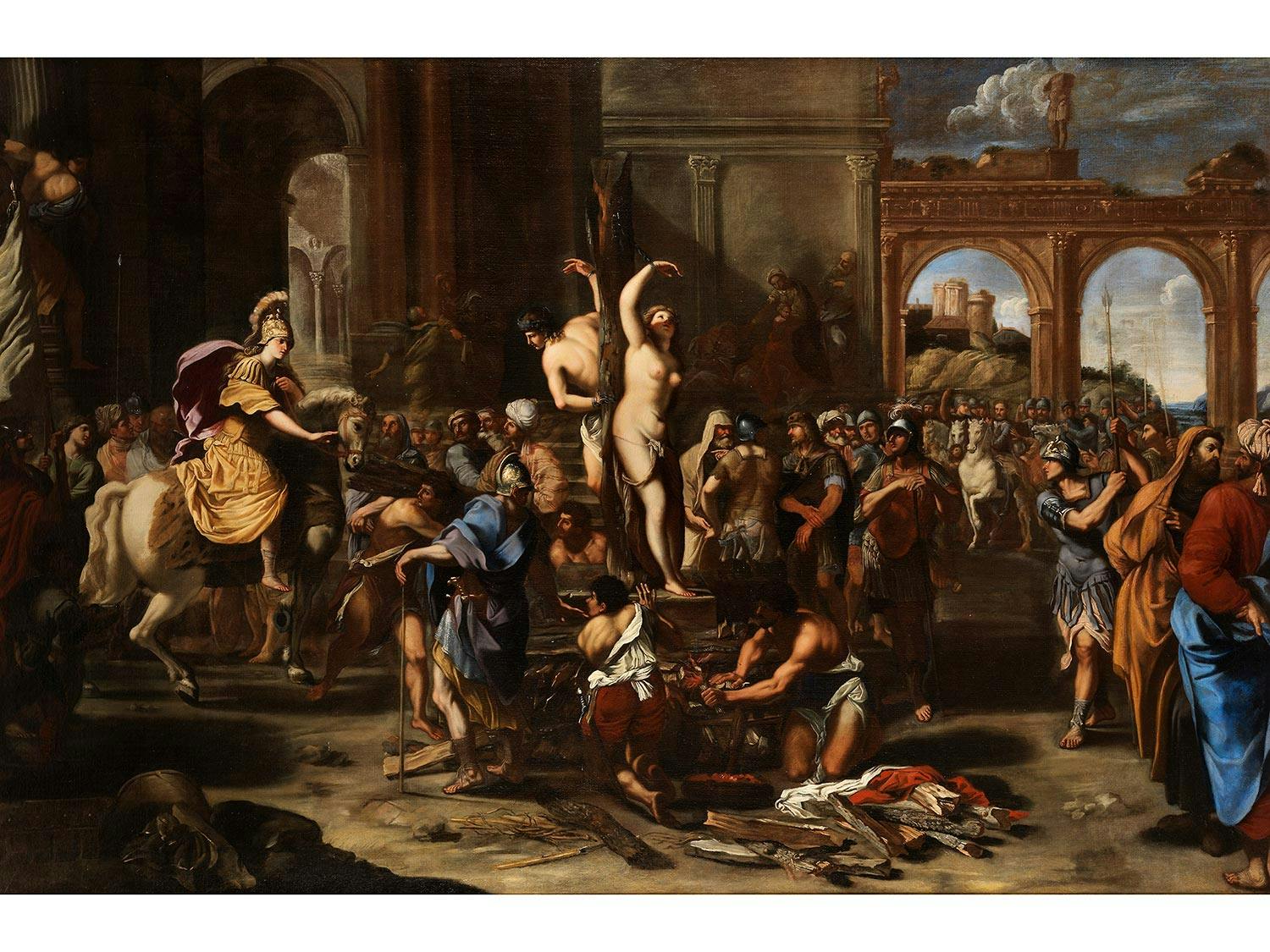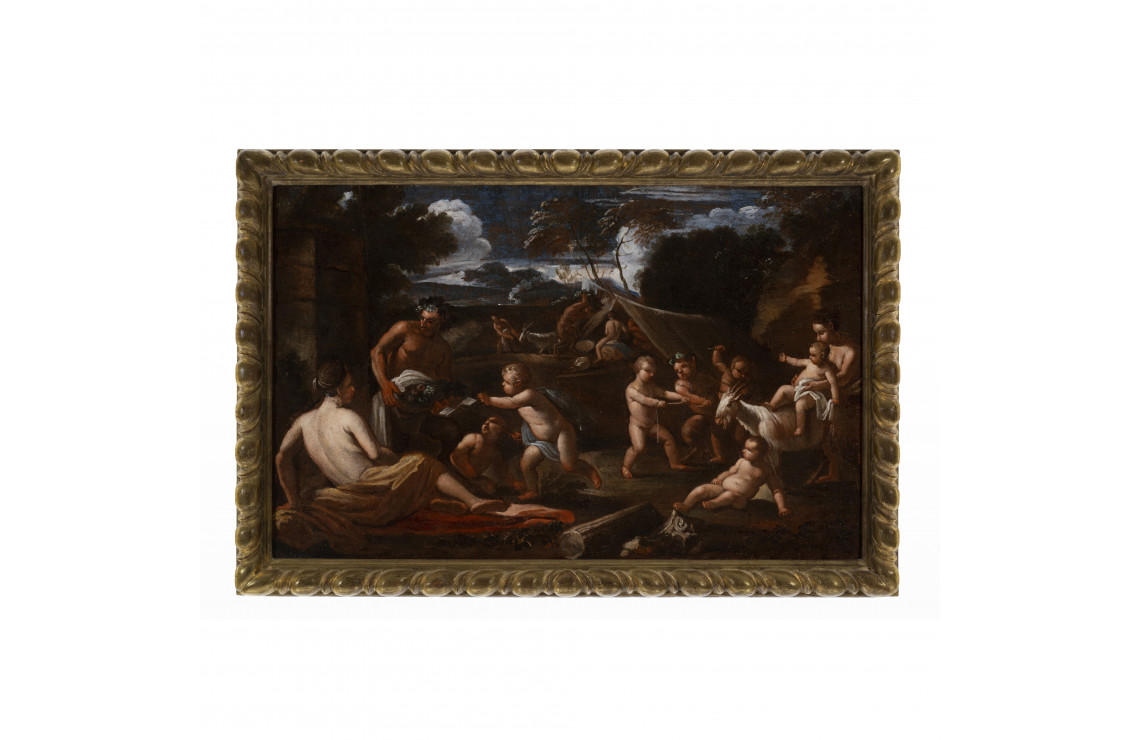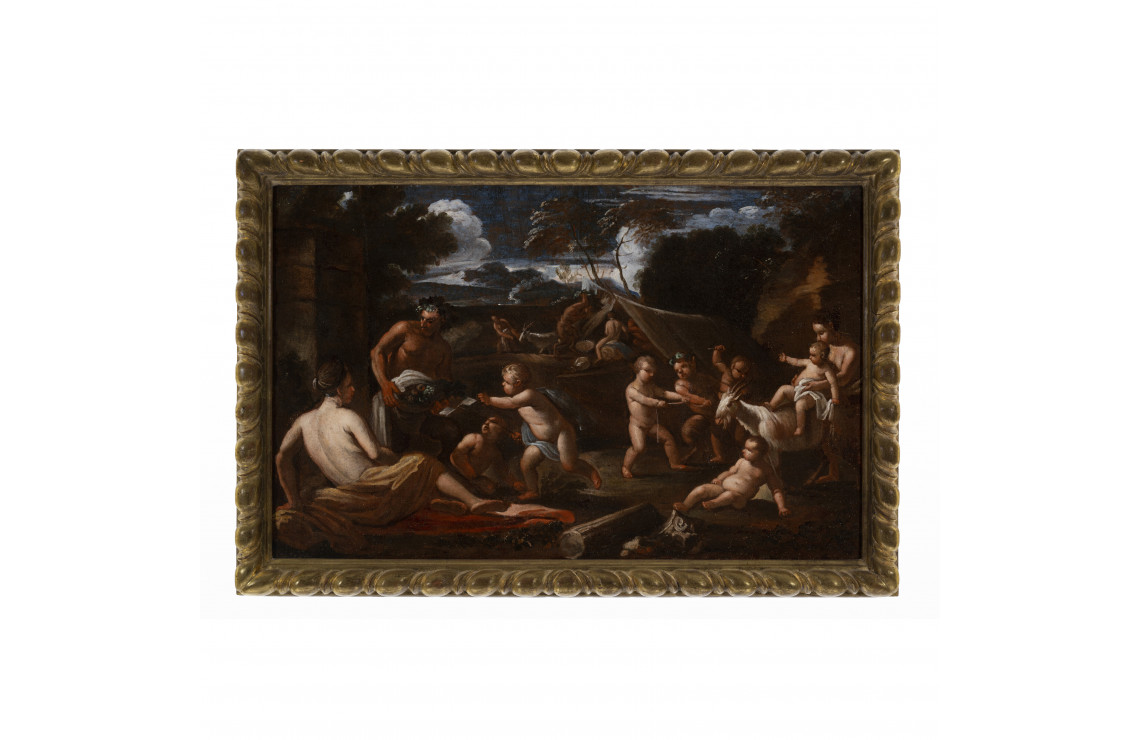(Les Andelys 1594–1665 Rome) A satyr carrying a nymph on his back, with putti and a faun in an arcadian landscape, oil on canvas, 101 x 76.5 cm, framed Inscribed on the stretcher, possibly by the 2nd Earl of Eldon: Silvans and Satyr: This picture belonged to the late Lord Chancellor Eldon. It represents Silvans and a Satyr, accompanied by Genii returning homewards. It appears to have been painted by Nicolas Poussin Eldon 1840. Incribed on a label on the frame: Salon d’Entrée, no.24 (possibly with another digit torn away) Provenance: possibly anonymous sale, London, Banqueting House, Whitehall, 2 June 1684, no. 167 (as ‘Manner of Nicholas [sic] Poussin’, as ‘A Woman and two Satyrs’); possibly collection of Joan Baptista Anthoine, until 1691, inventoried by the painters Jan Erasmus Quellinus and Pieter van der Willighen (as ‘No 169. Een Saterken dragende een Vrouken van Poussijn, 150 florins’); with John Blackwood, Soho Square, London, by 1769; possibly collection of the Duke of St Albans; possibly collection of Sir Simon Clarke, Bart., and George Hibbert, Esq.; their sale, London, 1802 (as ‘Nymph and Satyr, passing a Brook’, sold for £ 105); collection of John Scott 1st Earl of Eldon (1751-1838), Encombe, Dorset; thence by descent at Encombe to John, 2nd Earl, 1838; thence by descent at Encombe to John, 3rd Earl, 1854; collection of Sir Ernest Scott 1926; collection of Colonel Harold Scott, 1953; sale, Christie’s, South Kensington, 23 January 2007, lot 136 (as ‘After Nicolas Poussin’); where acquired by the present owner Literature: possibly E. Duverger, Antwerpse Kunstinventarissen uit de zeventiende eeuw, Brussels 2009, vol. 12, p. 94, no. 168; T. J. Standring, Poussin’s Erotica, in: Apollo, March 2009, pp. 88-94, no. 11, illustrated on p. 93 We are grateful to Christopher Wright for independently confirming the attribution to Nicolas Poussin after examination of the present painting in the original. Timothy Standring dates the present work to 1626-1627. He believes that this composition of Satyr Carrying a Nymph on his Back, with Putti and a Faun in an Arcadian Landscape, is the prime version and, as such, it is a significant addition to the early oeuvre of Nicolas Poussin A later treatment of the subject from 1629 is conserved in the Gemäldegalerie, Alte Meister, Kassel (inv. no. GK 459). The British Museum, London, holds what appears to be a preparatory drawing for the present work, dated to circa 1626 (inv. no. 1895,0915.929). Strandring, in comparing the British Museum drawing and the present work to the Kassel composition, notes that the drawing depicts water in the foreground and a forked tree trunk bisecting the figural group of nymph, satyr and putti, which are also features in the present composition, but which are omitted from the later Kassel version. The carnal and highly eroticised nature of Poussin’s output in this period is attributed by Standring to his relationship with the distinguished poet Giambattista Marino (1569-1625), first in Paris where the pair resided together, and then in Rome where Marino introduced the young painter to his sophisticated circle. Wright has observed that it has long been known that in his early years in Rome from the middle 1620s onwards Poussin adopted a free Baroque style quite different from the static grandeur of his mature works. The present motif, of a nymph riding on the back of a satyr, would have excited the artists’ clientele by challenging them to identify it from number of examples in antiquity. These might range from Cybele and the Satyr Marsyas to a depiction of l’amour vulgare. Poussin’s patrons included the antiquarian Cassiano del Pozzo (1588-1657), secretary to Cardinal Francesco Barberini. Standring suggests that the present composition likely depicts Satyrs playing Ephedrismos and relates it to a 1st Century AD intaglio ring in the collection of the Kunsthistorisches Museum, Vienna. The current canvas sits within a large group of similar works inspired by
(Les Andelys 1594–1665 Rome) A satyr carrying a nymph on his back, with putti and a faun in an arcadian landscape, oil on canvas, 101 x 76.5 cm, framed Inscribed on the stretcher, possibly by the 2nd Earl of Eldon: Silvans and Satyr: This picture belonged to the late Lord Chancellor Eldon. It represents Silvans and a Satyr, accompanied by Genii returning homewards. It appears to have been painted by Nicolas Poussin Eldon 1840. Incribed on a label on the frame: Salon d’Entrée, no.24 (possibly with another digit torn away) Provenance: possibly anonymous sale, London, Banqueting House, Whitehall, 2 June 1684, no. 167 (as ‘Manner of Nicholas [sic] Poussin’, as ‘A Woman and two Satyrs’); possibly collection of Joan Baptista Anthoine, until 1691, inventoried by the painters Jan Erasmus Quellinus and Pieter van der Willighen (as ‘No 169. Een Saterken dragende een Vrouken van Poussijn, 150 florins’); with John Blackwood, Soho Square, London, by 1769; possibly collection of the Duke of St Albans; possibly collection of Sir Simon Clarke, Bart., and George Hibbert, Esq.; their sale, London, 1802 (as ‘Nymph and Satyr, passing a Brook’, sold for £ 105); collection of John Scott 1st Earl of Eldon (1751-1838), Encombe, Dorset; thence by descent at Encombe to John, 2nd Earl, 1838; thence by descent at Encombe to John, 3rd Earl, 1854; collection of Sir Ernest Scott 1926; collection of Colonel Harold Scott, 1953; sale, Christie’s, South Kensington, 23 January 2007, lot 136 (as ‘After Nicolas Poussin’); where acquired by the present owner Literature: possibly E. Duverger, Antwerpse Kunstinventarissen uit de zeventiende eeuw, Brussels 2009, vol. 12, p. 94, no. 168; T. J. Standring, Poussin’s Erotica, in: Apollo, March 2009, pp. 88-94, no. 11, illustrated on p. 93 We are grateful to Christopher Wright for independently confirming the attribution to Nicolas Poussin after examination of the present painting in the original. Timothy Standring dates the present work to 1626-1627. He believes that this composition of Satyr Carrying a Nymph on his Back, with Putti and a Faun in an Arcadian Landscape, is the prime version and, as such, it is a significant addition to the early oeuvre of Nicolas Poussin A later treatment of the subject from 1629 is conserved in the Gemäldegalerie, Alte Meister, Kassel (inv. no. GK 459). The British Museum, London, holds what appears to be a preparatory drawing for the present work, dated to circa 1626 (inv. no. 1895,0915.929). Strandring, in comparing the British Museum drawing and the present work to the Kassel composition, notes that the drawing depicts water in the foreground and a forked tree trunk bisecting the figural group of nymph, satyr and putti, which are also features in the present composition, but which are omitted from the later Kassel version. The carnal and highly eroticised nature of Poussin’s output in this period is attributed by Standring to his relationship with the distinguished poet Giambattista Marino (1569-1625), first in Paris where the pair resided together, and then in Rome where Marino introduced the young painter to his sophisticated circle. Wright has observed that it has long been known that in his early years in Rome from the middle 1620s onwards Poussin adopted a free Baroque style quite different from the static grandeur of his mature works. The present motif, of a nymph riding on the back of a satyr, would have excited the artists’ clientele by challenging them to identify it from number of examples in antiquity. These might range from Cybele and the Satyr Marsyas to a depiction of l’amour vulgare. Poussin’s patrons included the antiquarian Cassiano del Pozzo (1588-1657), secretary to Cardinal Francesco Barberini. Standring suggests that the present composition likely depicts Satyrs playing Ephedrismos and relates it to a 1st Century AD intaglio ring in the collection of the Kunsthistorisches Museum, Vienna. The current canvas sits within a large group of similar works inspired by






.jpg)








Try LotSearch and its premium features for 7 days - without any costs!
Be notified automatically about new items in upcoming auctions.
Create an alert